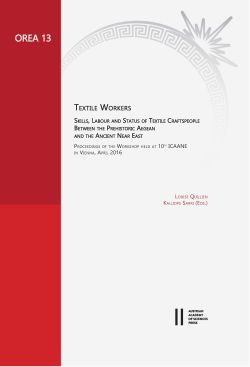
Textile Workers. Skills, Labour and Status of Textile Craftspeople Between the Prehistoric Aegean and the Ancient Near East, pp. 17-26, 2020/04/30
Proceedings of the Workshop held at 10th ICAANE in Vienna, April 2016
The Neolithic period in the Aegean has not yielded any textile remains. Thus, we know very little about textile production itself and even less about the identities of the earliest Aegean weavers. Some related information derives from their contemporary toolkit and from textile imprints on wet clay and, to this indirect evidence, pottery decoration may be added. This often shows symmetrically painted or relief systems, which are interpreted as textile patterns based on their strong similarity to patterns present on textile products throughout the ages. Such ornamentation can be considered to be representations of patterned textiles and they sometimes enable us to recognise even specific textile techniques. Moreover, textile patterns reveal the abilities of the weavers to calculate, conceptualise and represent geometrical shapes, to create hierarchies and to estimate sizes, volumes and values. This observation is the key to the connection between the Neolithic textile art and measuring systems, as yet unknown or unrecognised in this cultural stage of the Aegean area. This paper approaches the tracing of early metric systems in the Aegean Neolithic through the analysis of textile patterns and discusses the calculating abilities of textile workers in a culture whose calculating and metric systems are as yet unknown.
Keywords: Neolithic textiles; pottery patterns; visual mathematics; ethnomathematics; metric systems